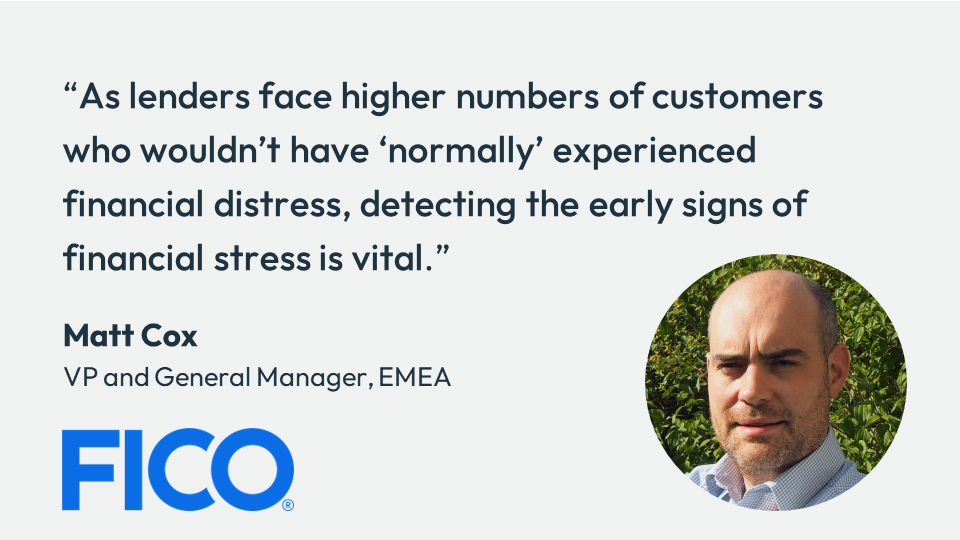Pre-Delinquency Measures for Financially Vulnerable Customers
How well individuals respond to pre-delinquency measures often hinges on the strategies lenders use to engage with them

Many households are in the midst of a cash-crunch. It’s driven by a combination of inflation, rising interest rates and higher energy costs. It’s a common picture across the globe, with the threat of rising delinquency rates seemingly everywhere. In fact, some forecasters are warning as many as one in four individuals are now struggling in the top-11 developed countries.
Despite many families so far managing to maintain their financial commitments — loans, credit card and mortgage repayments, as well as essential bills like utilities and rent — there are fears that rising inflation and interest rates may see a significant number struggle to make ends meet.
But among the critical learnings from the 2008 global financial crisis was the importance of flagging and helping at-risk and pre-delinquent borrowers as soon as possible to prevent financial disaster — especially when their deteriorating financial position was being influenced and undermined by a mix of external factors.
Any lender that is fast to act in supporting customers is likely to win and retain a competitive advantage over less well-informed market peers. How well individuals respond to pre-delinquency measures often hinges on the strategies lenders use to engage with them, especially if they’re treated quickly, fairly and pro-actively.

Impact of Delinquency and Spotting Early Warnings Signs on At-Risk Individuals
As lenders face increasingly higher numbers of customers who wouldn’t have ‘normally’ experienced financial distress, fallen into arrears or delinquency, spotting the early signs of financial stress are vital to success.
Relying solely on credit bureau data is simply insufficient and acutely inefficient. By the time they’re flagged as being at-risk it may be too late to avert the slide into delinquency. Regulators have been pressing for banks and lenders to ensure they’re working at the speed and scale of their market — or even faster. It’s a sentiment typified in the UK by the recent launch of the FCA’s new Consumer Duty.
Importance of Broader Data Sets and Real-Time Analysis to Informing Pre-Delinquency Strategies
Added to the challenges of early detection is the impact of BNPL and point-of-sale finance. There are now over 360 million BNLP users worldwide, with Sweden holding the largest BNPL market share, closely followed by Germany and Norway.
But without early insight and a clear, informed understanding of new or emerging segments of at-risk consumers, there’s a risk that lenders’ true degree of exposure won’t be realised until it is too late. As a result, there’s growing recognition of the value of accessing and combining a broader range of real-time datasets from third-party providers, often underpinned by "traditional" credit bureau insight.
The most critical element of this is the ability to deliver real-time analysis. Open Banking transactional data — which offers a view of how customers manage their finances and how their spending behaviour might be changing, as and when it is happening — may be key to informing and detecting the very earliest signs of financial stress and delinquency.
By constantly monitoring triggers and indicators of changing spending habits, increasing credit reliance and emerging financial circumstances, it's possible to pre-emptively instigate appropriate customer support, treatment and individual action weighted towards the right outcome for all parties.
The broader the dataset, its accessibility, its relevance and timeliness, as well as the means to transform it easily into insight — all this means the difference between successfully managing customers before their circumstances worsen and managing customers sliding into delinquency and long-term debt. This will be vital in enabling lenders to not only understand the individual’s position right now, but also where they are likely to be going for the rest of this year and beyond. It will also be crucial to the effective and strategic management of delinquency — and may also enable lenders help customers avoid its impact altogether.
A cloud-based platform is vital. FICO Platform, for example, provides the fastest, broadest access to the data on demand — at its most relevant, timely and when needed.
The Power of Two-Way Digital Dialogue – Taking an Omnichannel Approach
Understanding a customer’s spending behaviour, their motivations and their selective financial priorities are the first steps to success. But communication also plays a key role in successful engagement. It’s particularly successful when reliable customers have suddenly fallen foul of the current squeeze on household income and rate rises, compared to those who may have a longer-term, established vulnerability to debt.
Organisations dealing with financially stressed customers are likely to note a sense of embarrassment or resentment towards the circumstances they are in. Generic payment reminders are unlikely to be successful, cost-effective, or well received.
We’ve found that the most effective approach is through omnichannel communications. It means that when lenders have identified their customers and understand their situations, engagement with them is always relevant and generally fruitful when conducted through their preferred channels — be it email, SMS, WhatsApp, mobile apps, voice — and at their preferred times of the day. Based on how and when the customers choose to respond, lenders can adjust and ensure they are using the most appropriate channels for different steps of a customer’s journey.
Given the sheer number of potential customers that may now fall into arrears, there’s a pressing need for an automated, centralized view and coordination of interactions, using adaptable, top-performing tools like FICO Customer Communications Services. This enables customers to self-select their preferred payment options through the channel that best suits them, as well as providing a critical open access route to keeping in touch during the height of the crisis.
Outbound contact is fully automated, via the customer’s channel of choice, and typically includes self-service payment terms. Not only have we found the success rate to be much higher, at around 80%, but it reduces operational costs and helps contact centre teams focus on customers seeking immediate relief, who need human interaction to deal with their financial difficulties and help prevent individual delinquency.
Pre-Emptive Support Is the Key to Unlocking Lasting Customer Relationships
Lenders have a huge part to play in supporting and managing how quickly at-risk customers manage to return to some form of normal in their financial lives. Early identification of those who are beginning to feel the strain early on, with proactive support in contacting and meeting their needs, is vital. It’s not just about effectively managing financial distress and avoiding debt or delinquency, but about safeguarding and retaining and investing in good customers as lifelong prospects.
How FICO Can Help You Effectively Manage Pre-Delinquent Customers
- Watch a video on why customer-centric debt collection is critical.
- Read the post Even in a Crisis, the Best Collections Strategy Is to Avoid Collections.
- Find out why digital-first collections means thinking like a marketer.
- Read more background to the IFRS 9 learnings on models and operations.
Popular Posts

Business and IT Alignment is Critical to Your AI Success
These are the five pillars that can unite business and IT goals and convert artificial intelligence into measurable value — fast
Read more
FICO® Score 10T Decisively Beats VantageScore 4.0 on Predictability
An analysis by FICO data scientists has found that FICO Score 10T significantly outperforms VantageScore 4.0 in mortgage origination predictive power.
Read more
Average U.S. FICO Score at 717 as More Consumers Face Financial Headwinds
Outlier or Start of a New Credit Score Trend?
Read moreTake the next step
Connect with FICO for answers to all your product and solution questions. Interested in becoming a business partner? Contact us to learn more. We look forward to hearing from you.
